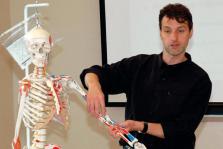Biomedical Engineering in the Classroom

Dr. Matt Davies is teaching Introduction to Biomechanics in fall 2009. The class covers static, dynamic and structural analysis of the musculoskeletal system, mechanical behavior of bone and soft tissues, and analysis of common engineered implants.
“The course is designed to give students a basis for further work in such areas as the designs of implants, injury biomechanics, orthopedic medicine and other topics,” Dr. Davies said. “Class enrollment was capped at 25 the first two years and it was full. This year it was capped at 30 and it is full.”
An assistant that helps Dr. Davies in the class is a full-sized skeleton. “To conduct a mechanical analysis of the human body and calculate joint and muscle forces during movement, the student must understand the geometry and anatomy of the bones,” Dr. Davies said. “The skeleton also shows the locations of the muscles and their connection points, which are crucial for understanding linkages.”
Two other biomedical-oriented undergraduate courses have been developed in the college in recent years. The technical elective Introduction to Biodynamics was developed by Dr. Nigel Zheng and attracted 19 students when it was taught in spring 2009. The class Introduction to Biomaterials was taught to 25 students in fall 2008 by Dr. Ahmed El-Ghannam, and covered bone reconstruction, soft tissue reconstruction, metals used for artificial implants, and the use of polymers and ceramics in medical applications.
“We also have many graduate students in the bioengineering area who are now using biomaterials in their research,” Dr. El-Ghannam said. “To serve these students, I am teaching Advanced Biomaterials and Tissue Engineering. Among its topics, this course introduces tissue engineering approaches to treat cancer and infection using resorbable biomaterials as scaffolds for drug delivery.”
The newer graduate course complements other biomedical-engineering focused graduate courses in the college such as the “Thermal Applications in Biomedical Engineering,” which is taught by Dr. Gloria Elliott.
“What all of our biomedical engineering courses have in common,” said Dr. Robin Coger, director of the Center for Biomedical Engineering Systems, “is the goal of giving our students the tools they need to engineer clever solutions to the complex problems of this interdisciplinary field. Not surprisingly, the selection of courses we are able to support has continued to increase as the number of faculty conducting bioengineering research within our college has increased.”